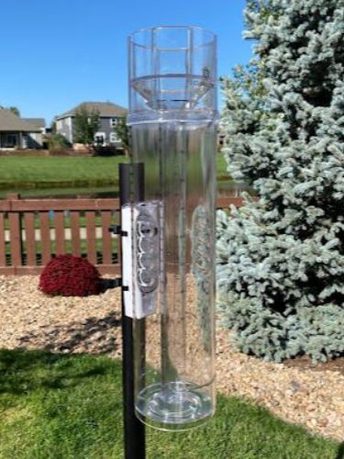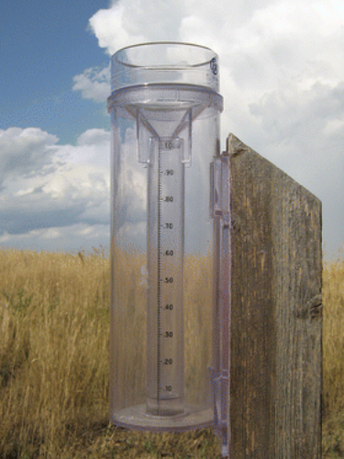Posted by Climalytic Instruments, LLC on 6th Feb 2024
10 Reasons to have a Manual Rain Gauge
Manual Precipitation Gauges
We are frequently asked, “Given the abundance of automated, self-emptying precipitation gauges on the market, why would I want to buy and use a manual precipitation gauge?” Well, it turns out there are a number of great reasons! Read on to learn about our top 10 reasons to own and use a manual precipitation gauge.
But first, we need to define what we mean by a manual precipitation gauge. A manual precipitation gauge is simply an instrument that captures precipitation and stores it in a cylinder. The precipitation is then measured and emptied manually by a human, as opposed to an automated gauge that measures and self-empty’s the precipitation. The National Weather Service 8-inch standard rain gauge exists at virtually every official climatological station. Although the 8-inch (diameter) standard rain gauge is preferred, a 4 inch diameter plastic gauge is an acceptable substitute at some locations. The 8” standard rain gauge has a capacity of 20 inches whereas the smaller 4” plastic gauge's capacity is 11 inches. With that said, our new 4” TROPO precipitation gauge holds up to 13 inches, making it the premium option for both CoCoRaHS volunteers and other backyard weather enthusiasts. There are many other manual rain gauges on the market, but they generally do not have the build quality or accuracy required for scientific applications.

Above: NWS Standard 8” Rain Gauge

Above: TROPO 4” Precipitation Gauge

Above: “Stratus” 4” Precipitation Gauge
The Top 10 Reasons
10.
Even with co-located automated instrumentation, manual gauges often provide the official precipitation measurements at National Oceanic and Atmospheric Administration (NOAA) observation sites. For this reason, manual precipitation records from sources such as the Global Historical Climatological Network (GHCN) provide the most accurate historical record for analyzing climate trends.
9.
Manual gauges do not require power or internet, thus making rural and remote measurement easy, possible and affordable.
8.
Manual gauges are not self-emptying, thereby offering visible, satisfying, and unequivocal truth of the accumulated precipitation without any derivation estimation schemes applied (counting tips, inferences from optics or acoustics) before the precipitation is automatically emptied.
7.
Measuring fresh snowfall and the snow water equivalent (SWE) with automated instrumentation is rarely as accurate as that from a skilled weather observer using a manual precipitation gauge. In fact, most precipitation gauges integrated into consumer-grade weather stations use a tipping bucket concept (see #9) that is not capable of measuring frozen precipitation, unless the gauge is equipped with a heater.
6.
Manual precipitation gauges tend to be more affordable than automatic alternatives. Additionally, it can be difficult and time consuming to properly set up and calibrate an automatic gauge. This makes manual precipitation gauges a great option for not only experts, but also for those who have little to no meteorological training.
True story: Tye Parzybok (Climalytic, CEO) once served as a meteorological expert for a forensic case where the plaintiff was a landowner suing a water utility company over poor land reclamation after a large water pipeline was installed across several miles of his private property through eminent domain. The land owner purchased several manual rain gauges and placed them around his property to measure and document rainstorms that were causing unduly erosion and damage to the property. The manual precipitation gauge data proved to be a vital piece of information in proving the land reclamation was not holding up to the rainfall intensities it was designed for.
5.
Manual gauges require recurring human interaction, and are therefore generally maintained, cleaned and operated with more care and attention than automated gauges.
4.
Anyone can own and operate a manual precipitation gauge since they are economical and easy to deploy. This promotes vast networks of observers offering excellent coverage of storms and “ground truth” information for aiding hydro-meteorologists in reconstructing storm events for purposes of hydrologic design, forensic cases, hydrology models, precipitation studies, and much more!
3.
Manual gauges can be easily and quickly deployed to monitor and confirm precipitation characteristics at weddings, special events, fairs, festivals, golf tournaments, fundraisers, outdoor concerts, parades and any other outdoor event for purposes of “rain insurance” policies/claims.
True story: Tye was once hired by an insurance company to use a manual rain gauge to measure hourly rainfall data during the filming of a costly car commercial along the Oregon Coast. The scenic Oregon coast is an ideal place for car commercials, but it is also prone to rainy, drizzly weather that could impact the production of a TV commercial, so the automaker protected themselves by taking out a rainfall insurance policy that would trigger a claim based on measured rainfall from a manual gauge.
2.
Manual precipitation gauges simply last longer, are more reliable and are more accurate given they don’t have moving parts, electronics, batteries, or required periodic calibrations. In particular, manual gauges are more reliable and accurate in measuring extreme precipitation because they don’t suffer from transmission issues and/or under-catch associated with the mechanisms measuring the precipitation. The most common automatic rain gauges use the tipping bucket concept, which is a fairly simple and generally effective design: two tiny buckets are exposed alternatively to collect rain beneath a funnel collecting the rainfall. A tip occurs when a predefined amount of rain (e.g. .01”) collects in one of the buckets and is forced to empty, thereby exposing the other bucket to fill. The gauge computer simply counts the number of tips and multiplies it by the capacity of the bucket to determine the amount of rain. During the emptying of one bucket, there is a split second of time when a bucket is not directly below the funnel. For this reason, it is a well-known and accepted fact that tipping-bucket rain gauges tend to underestimate rain at high rainfall rates. There are ways to mathematically make estimated adjustments for this, but with the manual gauge there is no error correction necessary.
1.
Manual rain gauges are simply more fun and engaging. They offer a great way for anyone to participate in precipitation measurement, which helps support a great number of important causes. Measuring precipitation can be a healthy part of a daily routine, particularly seniors who benefit from a daily walk to the rain gauge and reporting/recording the data.
In Conclusion
It’s for the reasons above that the largest precipitation observation network in the United States is CoCoRaHS, whose volunteers use four-inch manual precipitation gauges.
It is also important to note that while manual gauges have many advantages at the moment, a “Top 10 Reasons to have an Automatic Gauge” could easily be written as well! As time goes on, it is great to see so many new innovations and improvements in both manual and automatic precipitation gauges.

